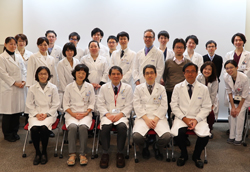
Overview

It is said, in order to evaluate the quality of a hospital, observe the Radiology department's activities.
One of the important tasks of the Radiology Department is to practically apply diagnostic imaging techniques to treatment. This principle is used in many fields including percutaneous vertebroplasty, uterine fibroid embolization, emergency interventional procedures to stop bleeding, selective injection of chemotherapeutic drugs, the percutaneous collection of tissue specimens and puncture aspiration of abscesses, bile duct decompression, and radiowave-based treatment among others. All of these interventions are performed in close collaboration with staff of the Emergency, Gastroenterology, Pulmonary, Neurology and other departments, respectively.
Since this hospital also has a role as a teaching hospital, medical students from Tokyo Medical and Dental University as well as St Marianna University School of Medicine regularly undergo clinical internship at the Radiology Department.
The hospital is also a training institution for radiology and interventional radiology specialists who are certified by the Japan Radiological Society and the Japanese Society of International Radiology.
Diseases and Expertise
Areas of expertise and specialization
Two characteristics of the medical care that St Luke’s International Hospital prides itself in on a national level, are comprehensive diagnostic imaging and interventional treatment involving the application of diagnostic imaging techniques.
Comprehensive diagnostic imaging is the work of the Radiology Department. The human body namely does not only consist of a single organ – it is made up of many different organs and systems that are interconnected with each other. The role of the Radiology Department is to approach the human body in its totality, as it performs diagnostic imaging of every part. These specialists also have to skillfully select the most appropriate procedure among CT, MRI, echography, etc., depending on the characteristics of the target organ and the disease.
The images obtained by various tests, not only CT and MRI, but also plain X-rays, echograms, different kinds of contrast studies, etc., are responsibly read and interpreted. The department also has experts who have further specialized in the interpretation of images specifically obtained in such fields as the chest, cardiovascular system, breast, nervous system, gastroenterological system, female pelvis, urology, pediatrics, bones and joints, etc.
This diagnostic imaging environment is also available for use by patients visiting the general outpatients department, and can serve the purpose of obtaining an image-based second opinion.
The other characteristic of care is the provision of interventional treatment involving the application of diagnostic imaging techniques (interventional radiology). Percutaneous vertebroplasty, which is recently receiving much media attention, is one such procedure in which St Luke’s International Hospital has top-class experience across the country, and which is performed in more than 200 cases every year. This procedure provides dramatic relief to numerous patients suffering severe low back pain. A special outpatient division has been opened for patients in whom this procedure is indicated.
Procedures like coil embolization of brain aneurysms and stenting of the carotid artery are performed at the Neuroendovascular Therapy Department.
We proactively perform a wide range of procedures from arterial embolization to stop bleeding in case of emergencies with traumatic or gastrointestinal hemorrhage, to such interventions as chemoembolization and radiowave therapy for liver cancer. As part of the diagnosis and treatment of breast cancer, percutaneous tissue collection using MRI, mammography or ultrasound is performed at the Radiology Department, in cooperation with the Breast Surgery Department. We also treat hemangioma and vascular malformations of the extremities, and perform embolization of uterine fibroids, among other procedures. These are all performed in close cooperation with the Gastroenterology, Plastic & Reconstructive Surgery, Dermatology and Obstetrics & Gynecology departments, respectively.
Target Patients
In routine practice, radiologists at the Radiology Department treat patients in collaboration with physicians of the various clinical departments. Percutaneous vertebroplasty is performed directly at the Radiology Department outpatient division, or in the ward of inpatients. Patients targeted for this procedure are those with unbearable continuous low back pain that has developed after the patient fell or landed straight on the buttocks, and that prevents the patient from walking. This procedure is most indicated in case of compression fracture of an unstable vertebra. This disorder can be diagnosed and treated on an outpatient basis. Please inquire at the outpatient department.
Equipment
- 4 MRI devices (2x 3.0T MRI, 2x 1.5T MRI)
- 3 MD CT [320 slice, 64 slice, 16 slice]
- 2 Subtraction Angiography C-arm
- 3 SPECT Nuclear Medicine Diagnosis Equipment
- 3 Ultrasound Equipment Completely Filmless Environment due to PACS from 2003
